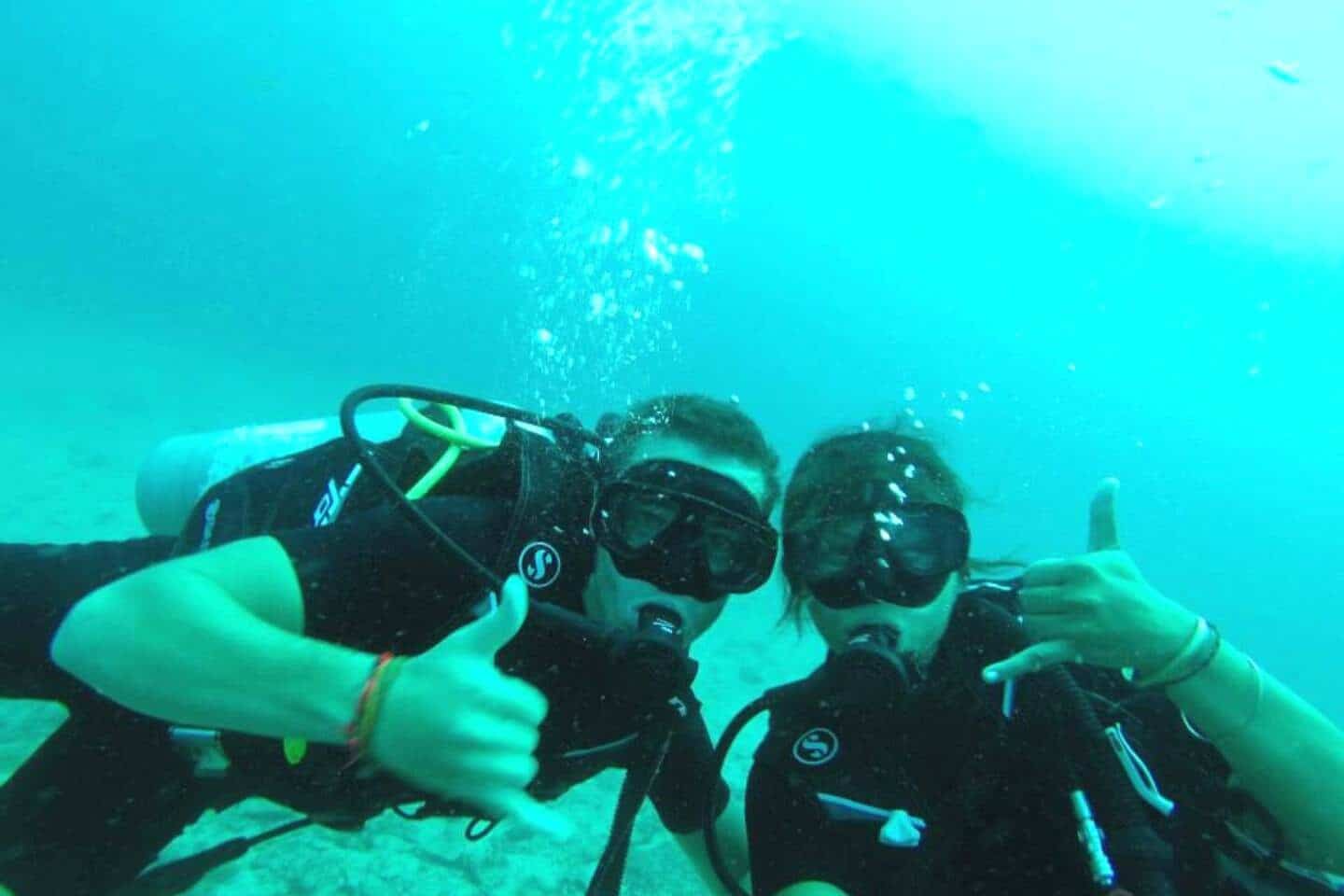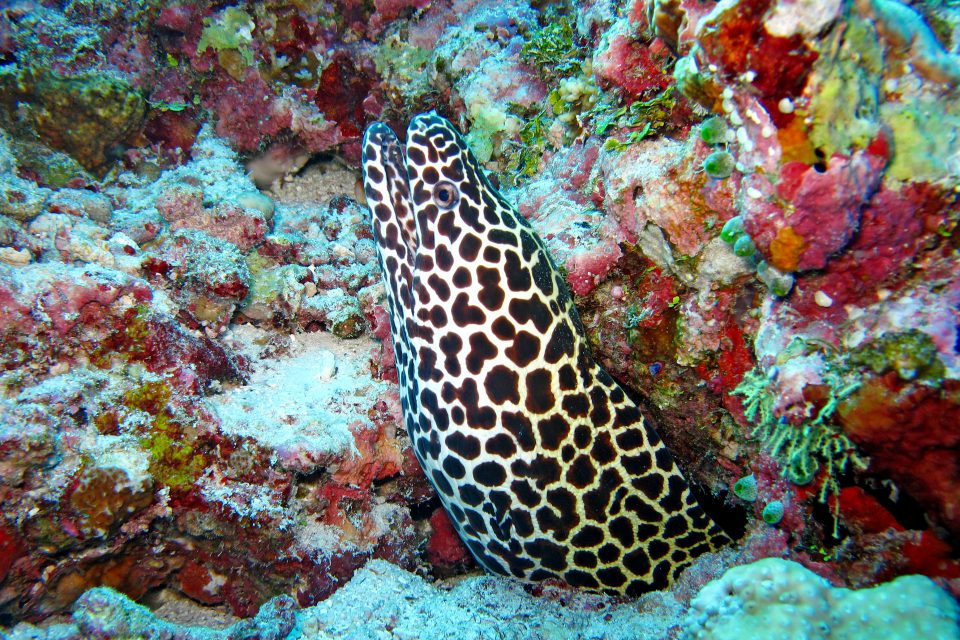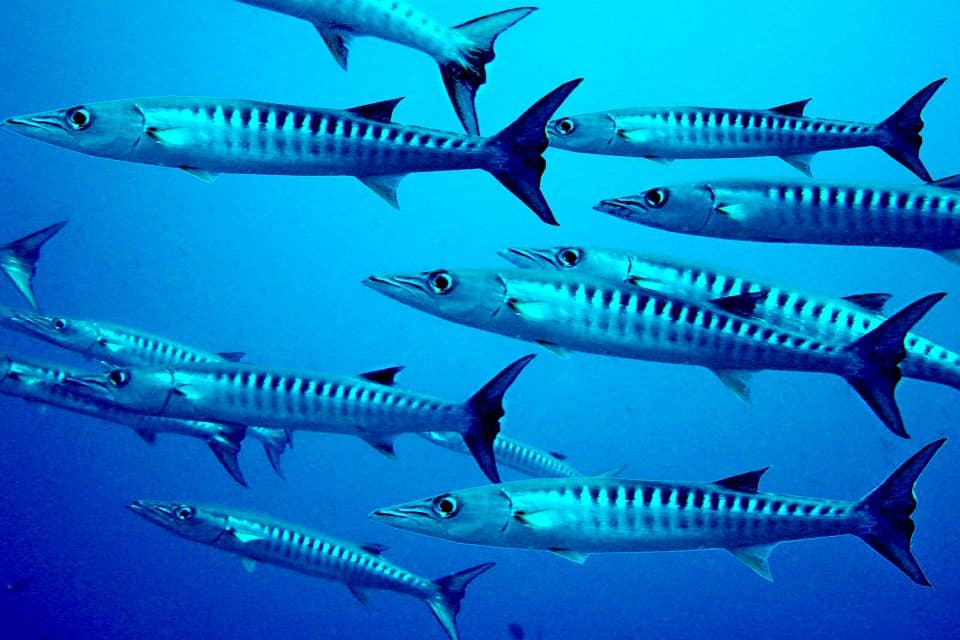Looking for the best scuba diving in Thailand? In this article, I am going to walk you through a few of the best dive sites as well as tips on when to best go.
Thailand, one of the world’s top tourists’ destinations, receiving over a million people per year. It goes without saying that a lot of people flock here due to its ridiculously stunning beaches. Located in the heart of South Asia, it offers miles of tropical beaches, exhilarating cultural experiences, and fantastic marine and reef life for underwater enthusiasts.
These places vary from wild current swept rocky landscapes to gentle sloping coral reef. To help you plan your next underwater holiday, here are a few of the best dive sites in Thailand waiting to be explored!
We spent months scuba diving our way around Thailand, in fact, Thailand is where Tom (founder of this blog) got certified. If you enjoy diving in warm waters and seeing colorful fish and reefs, Thailand is for you.

View Contents
- Thailand Diving
- Best Time to Scuba Dive in Thailand
- Best Dive Sites in Thailand
- 1. Hin Daeng and Hin Muang
- 2. Koh Dok Mai
- 2. Richelieu Rock, Koh Tachai, and Koh Bon
- 3. Similan Islands
- 4. Chumphon Pinnacle
- 5. HTMS Sattakut Wreck
- 6. Sail Rock
- Types of Diving in Thailand
- Liveaboard Diving in Thailand
- Scuba Diving Safety in Thailand
Thailand Diving
To quickly answer your questions, here’s our list of the top dive sites all over Thailand and the various locations for each one. In this article, I will give information on each location and go into specifics on what you can see in each destination.
One of the reasons why Thailand is so popular is due to the fact that it is situated in the Andaman Sea.
Scuba diving in the Andaman Sea is a must-do experience for any diving enthusiast. Located on the west coast of Thailand, the Andaman Sea is home to some of the best diving spots in the world, with crystal clear waters and a rich diversity of marine life.
Divers can explore stunning coral reefs, deep underwater canyons, and the remains of shipwrecks while seeing exciting things like whale sharks, manta rays, eels, and other large pelagics.
In a nutshell, here are the most famous islands in Thailand, along with the best dive spots near them. Please note that since some of these islands are located near each other, you can reach some of these dive sites from different places.
- Similan Islands: East of Eden, Elephant Head Rock, North Point, Deep Six, Boulder City, Shark Fin Reef, Christmas Point.
- Koh Tao: Chumphon Pinnacle, Southwest Pinnacle, Sail Rock, Shark Island, White Rock, Green Rock, HTMS Sattakut Wreck.
Koh Tao is a popular spot for people to learn how to scuba dive as it has some of the cheapest rates in Thailand. A lot of people also opt to take their advance course here. - Phuket: Richelieu Rock, Hin Daeng and Hin Muang, Shark Point (popular spot for Leopard Sharks)
- Koh Phi Phi: Bida Nok, Bida Nai, King Cruiser Wreck, Palong Wall, Koh Dok Mai.
- Koh Lanta: Koh Haa, Hin Daeng, Hin Muang, Koh Bida Nok, Koh Bida Nai, Koh Rok.
- Koh Phangan: Mae Haad, Haad Salat and Haad Yao Reefs
✨The 1 Thing We Never Leave Home Without…✨

Coming from someone who has been traveling the world for the last 8 years AND has been in the hospital 2x, travel insurance is something everyone NEEDS to get. Get a quote below!
Best Time to Scuba Dive in Thailand
Thailand is in a tropical region and therefore one can go diving anytime, all year round. However, the best conditions exist between November and April as Sharks visit from February to May. With bathtub like temperatures of 28-31 degrees, your diving conditions could not be better.
If you want to be a bit more specific, if you are visiting dive sites in the Andaman Sea, it is best to come from October to April. You have the Giant Manta Rays which arrive at the Similan Islands in March or April.
During the months of May, expect heavy rainfall which is why a lot of the marine reserves are closed (until mid-October). During those times, diving in places along the Gulf of Thailand is a lot more recommended.
Best Dive Sites in Thailand
1. Hin Daeng and Hin Muang
Location: 50km off of Ko Lanta (2 hours by boat or 1 hour 20 minutes from Koh Phi Phi)
Highlights: Large pelagics, cave dives, Grey Reef, and Leopard Shark sightings, and if you’re lucky, you can also spot a whale shark that occasionally hangs around this spot.
To start things off, I’ll begin with my personal favorite, Hin-Daeng and Hin-Muang also known as the red and purple rock. If you’re a ‘life-below-water’ fan, this is your best shot to see gray sharks and manta rays.
However, that’s not all you get as at the red and purple rock; you get an exciting experience of diving Thailand’s biggest vertical wall, next to caverns and caves that add a thrill to the adventure.
These dive sites are feeding grounds for pelagic fish, allowing you to see lots of large creatures during your dive. Leopard Sharks are known to hang around these waters and if you’re lucky, you can spot a few of them during your dive.
The currents in these areas can be quite strong so experienced divers are recommended. Alternatively, aim to go during calmer days.

2. Koh Dok Mai
Location: In the middle of Phuket and Koh Phi Phi (about 90 minutes by boat from Phuket)
Highlights: Several species of moray eels, large soft corals, sea horse, and leopard sharks which often lurk around.
Another great dive is the Koh Dok Mai, a superb wall and drift dive with crevices lurking, hidden caves and limestone rock face. If you want to have an electric experience, this is the place to go. When you’re diving, keep an eye out or you might miss an eel peeking out of the yellow tube corals.
The best time to dive at this specific place is around midday as the sun provides an illuminating effect, giving you the perfect glimpse of baby sharks nursing, depending on the season.
There are three sides of walls making up this large limestone rock, boasting of different creatures which can be found in every nook and cranny. Because of its interesting formation, this can also be done as a night dive.
A small cave (about 5m straight in) leads to a huge cavern with fairly strong currents adding to the whole thrill and excitement of this dive spot. This is why it’s leopard sharks often frequent these waters!
Diving in Phi Phi and Phuket Island: If you want to try scuba diving in these locations, here are some of our recommended tours and dive companies. Introductory Dive Session in Koh Phi Phi and PADI Open Water Course in Phuket.

2. Richelieu Rock, Koh Tachai, and Koh Bon
Location: Located between Similan and Surin Islands (accessible via Liveaboard of from Khao Lak)
Highlights: Possibility of seeing whale sharks, manta rays, and eagle rays, and other marine life.
Richelieu Rock is a horseshoe-shaped rock in the Andaman Sea and is one of the best dive sites in Thailand. If you are out to look for barracuda tornadoes and schools of tropical fish, this is the place to be.
Be sure to spot seahorses, pipefish, cuttlefish and even shovelnose rays while you are there. The huge center pinnacle surrounded by small rocks is covered by soft corals, anemones, sponges and large sea fans. It is truly a sight to see!
Although there are lots of dive sites in Thailand where you can see whale sharks, the nutrient-rich waters contain loads of planktons which attracts whale sharks all the time.
This dive site is HUGE attracting a lot of large and small creatures waiting to be discovered. The currents in these dive sites can be a bit strong so again, only advanced or experienced divers are recommended to give it a try.
Similarly, Koh Tachai and Koh Bon are sites that are part of the Similan Island National Park. It is well known for being one of the best dive sites in Thailand where you can spot mantas. Apart from this, you can also often find black tips reef sharks and eagle rays.
Koh Tachai is also known for its epic swim-throughs and channels which you can drift around in. Together, these islands in the North of Similan are known as the best diving in Thailand. Altogether, they boast of large pelagics like barracudas, trevally, and tuna.

3. Similan Islands
Location: Similan National Marine Park (Mostly explored on liveaboards)
Highlights: The untouched waters, the wide variety of corals and fish, leopard sharks, turtles, and the challenging maze-like swim-throughs and currents.
Scuba diving in the Similan Islands is considered to be one of the top diving experiences in the world. These islands are a group of nine islands located in the Andaman Sea, approximately 70 km northwest of Phuket.
The islands are part of a national marine park and are known for their crystal clear waters, stunning coral reefs, and abundant marine life.
Divers can explore a variety of dive sites around the Similan Islands, each with its own unique features. The most famous dive sites include Elephant Head Rock, East of Eden, and Richelieu Rock.
Expect to see an array of marine life, including schools of colorful fish, sea turtles, rays, and even whale sharks during the season. The visibility is often exceptional, ranging from 20 to 40 meters.
Located within the premises of the National Park, the Similan Islands offers one of the best diving sites in the entire of Thailand. Within the area, there are about 20 different dive sites that you can explore, all boasting of a wide variety of creatures.
Elephant head or (Hin Pusar) is known to be one of their best dive spots within the area due to its intricate maze-like rocks composed of swim-throughs, channels and gorges reaching depths of over 40m. It is really something else and is pretty out of this world! Other notable sites within the area are Christmas Point and Fantasea Reef.
If you want to experience liveaboard diving, click the button below to read our full Similan Liveaboard guide which has details on the best boats, when to go, and more.
4. Chumphon Pinnacle
Location: Koh Tao
Highlights: Large schools of fish, colorful reef, and marine life.
If you’re looking for great diving along the Gulf of Thailand, Koh Tao is probably your best bet. Popular amongst people doing PADI certification lessons, no dive is complete in Koh Tao without visiting the Chumphon pinnacle.
The entire top bit of the pinnacle is full of anemone, making it home to loads of fish, white moral eels, crabs, and shrimps.
The deeper you go, you get to see more holes as you descend down this wall. Along the way, you will see juvenile barracudas, trevallies, bannerfish and a lot more. Whale sharks sometimes come for a visit, depending on the season. Other types of sharks used to frequent this area but they aren’t so common anymore.
Getting PADI certified in Koh Tao: For us, if you’re interested in scuba diving, Koh Tao, Thailand is one of the best places to do it due to the calm waters and the stunning dive sites. If you’re not certified yet, consider getting certified in Koh Tao as it is also one of the cheapest places in the world!

5. HTMS Sattakut Wreck
Location: Off of Koh Tao
Highlights: Aside from the wreck itself, Grey Reef Shark, Great Barracudas, Pufferfish and various Flatworms.
The HTMS Sattakut Wreck is a popular dive site located in Koh Tao, Thailand. This site is a former Thai Navy vessel that was sunk intentionally in 2011 to create an artificial reef and diving attraction.
The Sattakut was a 47-meter-long, 600-ton ship, and it now sits upright on the ocean floor at a depth of around 30 meters. The wreck is covered in soft corals and sponges, providing a stunning backdrop for divers.
The site is suitable for advanced open water divers due to the depth and strong currents, but it is a must-visit for those who are interested in wreck diving. Divers can explore the ship’s interior and external areas, including the wheelhouse, engine room, and main deck, where schools of barracuda, snappers, and trevallies can often be seen.
HTMS Sattakut is one of Thailand’s premier wrecks which was sunk on 18th June 2011 near Koh Tao. Furthermore, the landing craft infantry, also known as (LCI) was one of the infamous assault ships during world war two.
This artificial reef harbors both of the two historical vessels which has turned into a home for various types of marine life. Additionally, it is the home to barracudas, groupers, schools of Fusiliers, blennies and moray eels.
For those of you who haven’t done any type of wreck dive, this is a good point to start and is definitely something that is out of the ordinary.
6. Sail Rock
Location: North of Koh Samui, in between Koh Pha Ngan and Koh Tao
Highlights: Large schools of Yellow Fusiliers, Trevally, Giant Morays, Large Groupers, Batfish, and if you’re lucky, Whale Sharks.
Sail Rock is a popular dive site located in the Gulf of Thailand, between Koh Phangan and Koh Tao. It is known for its unique pinnacle rock formation that rises up from the depths and is covered in vibrant coral and teeming with marine life.
Divers can expect to see schools of barracuda, trevally, and snapper, as well as larger pelagic species like whale sharks and bull sharks. The dive site is suitable for divers of all levels and offers both shallow and deep dives.
Hin Bai or Sail Rock is one of Thailand’s best wall dives. Lots of schools offer trips here which is something we highly recommend doing as diving is just fantastic.
People flock to Sail Rock as its vertical chimney is a fun ascend. The entire site is large enough to be explored by both students and more advanced divers as it plunges to around 40 meters.

Types of Diving in Thailand
Diving in Thailand is a treat due to its tropical waters. It is home to over 2125 different species of fish and has some of the best reef dives in Southeast Asia. A lot of people opt to learn how to scuba in Thailand due to its reasonable rates as well as its calm and clear waters.
Reef Diving
Reef diving in Thailand is nothing short of beautiful! The reefs here are abundant and well preserved, making it a hotspot for dive enthusiasts around the world. Although diving in Thailand is known for large fish and pelagics, there are also a few areas where you can enjoy macro diving.
Wreck Diving
If you enjoy wreck diving, you might want to consider heading to Pattaya, a place which is loosely labeled as the “wreck diving capital of Thailand” Pattaya is home to five wrecks, namely the HTMS Kut, HTMS Khram and HTMS Mataphon which are all World War II-era ships from the US Navy that were decommissioned and given to the Thai Navy.
The navy, later on, sank these ships to serve as artificial reefs. You can also see the S.S Suddhadib and the Bremen Wreck no more than 1hr down the coast from Pattaya.
Located not too far from Pattaya is an island called Koh Chang which is home to the largest shipwreck dive spot in all of Thailand! The HTMS Chang is 100m in length and can be explored thoroughly!
Liveaboard Diving in Thailand
Liveaboards in Thailand are a popular way for diving enthusiasts to explore the country’s stunning underwater world. These are boats that offer accommodation and diving services, allowing divers to stay for multiple days and explore various dive sites.
Thailand has a diverse range of dive sites, including coral reefs, shipwrecks, and marine parks, which provide plenty of opportunities for underwater exploration. Liveaboards in Thailand typically operate in the Andaman Sea on the west coast, where the famous Similan Islands and Richelieu Rock are located, as well as in the Gulf of Thailand on the east coast, where the popular dive sites of Koh Tao and Chumphon Pinnacle can be found.
With crystal clear waters, abundant marine life, and stunning seascapes, liveaboards in Thailand offer an unforgettable diving experience.
Liveaboard diving is insanely popular in Thailand and is a great way to make the most of the best dive sites in Thailand. Most of the liveaboard in Thailand are usually 5 days and 4 nights, sailing to some of the most beautiful waters in the country.
While the itinerary varies, most of the boats take you to the Similan Islands where you can enjoy dives in secluded locations.
We’ve done a few liveaboards in Southeast Asia and have to say that they are one of the best ways to really make the most out of your diving trip!
Search for your dream liveaboard in Thailand here!
Scuba Diving Safety in Thailand
Generally speaking, diving in Thailand is extremely safe as there are plenty of easy beginner dives. While some dives have currents, the divemasters you are diving with should be able to give you a full breakdown of how technical each dive is.
There you have it! Hopefully, this article has given you a great overview of all the best diving in Thailand and has encouraged you to explore the underwater marine life in this country.
For the ultimate diving adventure, be sure to check out liveaboards in Thailand!
Planning to travel around the Thai Islands? Check out a few of our guides
- A Guide to Choosing the Right Thai Islands to Visit
- 15 of the Best Beaches in Thailand
- Our Travel Guide to Khao Lak
- Yoga retreats in Thailand
Inspired? Pin it!


Thanks for this article. I am a newbie diver so it is good to know these places.
I have only been to chumpon pinnacle 🙂
x
I’ve been wanting to try diving for the longest time but never really got to it. You picked such amazing spots for snorkeling and diving. The Similan Islands kinda reminds me of Palawan for some reason.
I”m going to Thailand for the first time this year and I can’t wait! I’ve wanted to dive with whale sharks for a while now, I didn’t realize you could do that there.
I don’t dive but there is no reason to let a good beach or crystal clear blue water go to waste. I love the waters and beaches in Asia. I have done some snorkeling though and these look like good spots for that also.
Can you believe that I’ve spent the majority of the last 8 years in Asia and I never tried diving? Crazy huh? I’ll definitely put this on my bucket list for next year and your post will surely help to find the best spots! Bookmarked and shared! Hope to see you somewhere around… Cheers from Bangkok!
I am certainly not a water baby but these photos make me want to conquer my fears and go diving. What camera and housing did you use to take the photos? They are amazing!!!
What great spots for snorkeling and diving. I’d love to visit in March or April with those giant manta rays, how amazing would that be.
I’m sure I did the two ones around Koh Tao, for the ones of Koh Phi Phi I’d need to check my dive log 😉
Thailand was the place where I learnt diving – oh, what a good decision it was!
Wow guys! These dive stops really reignited my enthusiasm for diving – sometimes I put it in the too hard basket (because I’m not very good at it – as you know!) but then I see incredible pictures of the underwater world and just want to get back out there to see for myself! Thanks for the inspiration!